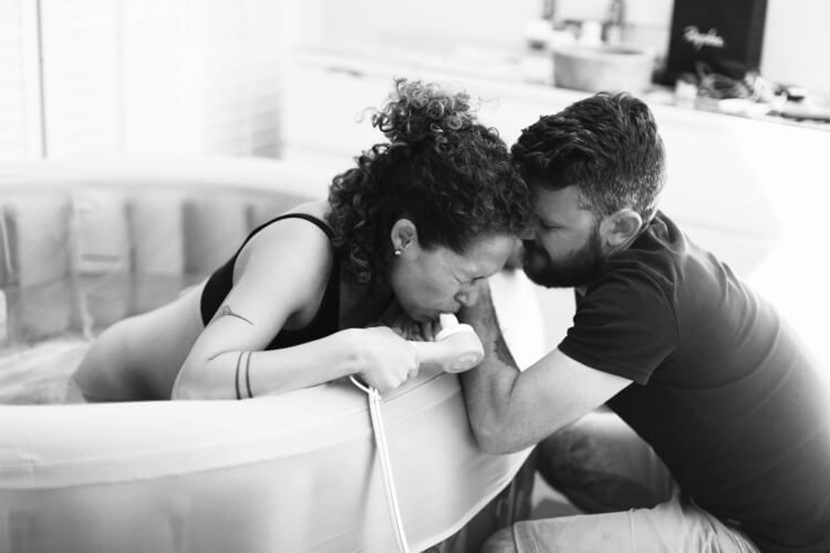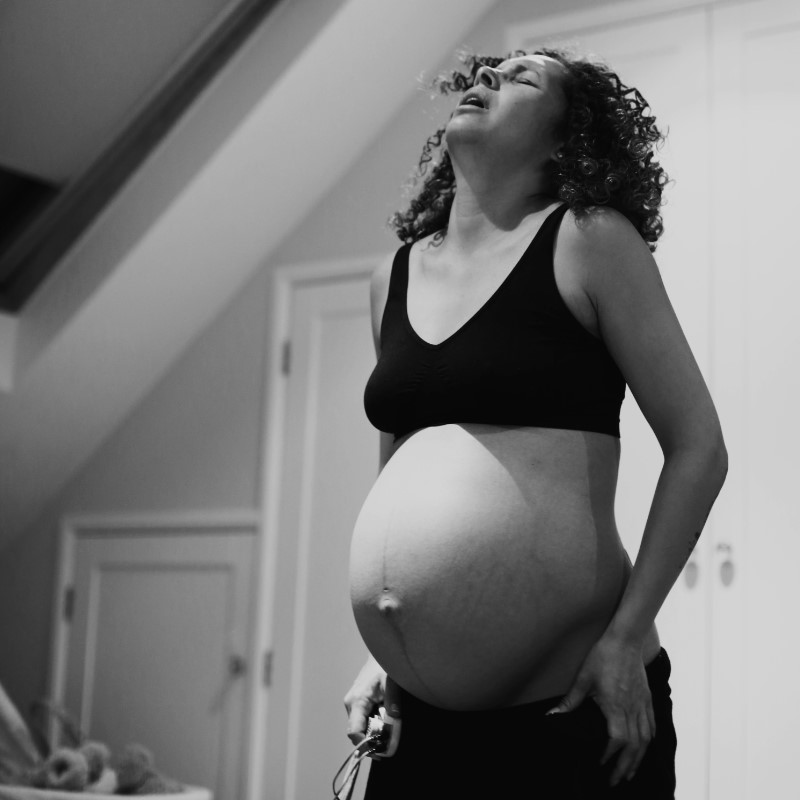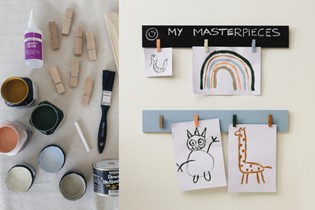Midwife discusses pros & cons of pain relief

Birthing your baby is an incredible, powerful experience. Midwife, Grace Strange talks us through the pros and cons of pain relief options.
Choosing pain relief for labour and birth is very personal. Everyone has a different pain tolerance and preferences. For some women they want to have an unmedicated birth, for others they want an epidural put in before their labour even begins! The wonderful news is that in New Zealand everybody gets a choice, there is a wide variety of options, and in most cases you can use a combination of the below pain relief options throughout your labour. It's hard to grasp exactly what each option is while you’re in the throes of labour pains, so make sure your antenatal class covers all your options so you’re totally clued up prior to the big day.
NATURAL PAIN RELIEF
There are a number of helpful coping strategies to help assist with pain relief during labour and birth if you are aiming for an unmedicated birth. But even if you are planning an epidural, it is helpful to know some of these techniques, such as breathing and meditation, in case there is an unexpected situation that arises during your labour or birth. These techniques can help you keep calm, centered and cope with the situation around you.
The point of all these natural pain relief techniques is to keep your mind and body in as calm a state as possible. This is so your contractions are as effective as they can be and that your baby can be born safely. We want high amounts of oxytocin which stimulate powerful contractions during your labour – opening your cervix and moving your baby down into the birth canal. We also want high amounts of endorphins which are calming and pain-relieving hormones that are produced when you face stress or pain. In contrast, we want to keep adrenaline (which is released in response to fear, extreme pain and stress) and cortisol (your stress hormones) as low as possible. Let's look at some of the ways we can achieve this…
Distraction
The goal of this one is to keep your mind distracted from the pain. We all know that the more we concentrate on the pain of something, the more it hurts. Distraction is the key to keeping your mind focused on something else. You might like to watch TV or movies, play cards or a game, chat with friends, or check that everything is packed in your bag.
Movement
This is a wonderful way to use gravity to help the baby get down into the pelvis. It will also help to distract your mind from the pain as you are doing something different with your body. Making sure you stay mobile and upright will mean that gravity is using the weight of your baby to put pressure on your cervix, helping it to dilate. You can also try doing exercises like curb walking, going up and down the stairs, bouncing on a Swiss ball or dancing.
Breathing
We all know the power of the breath and it being the biggest tool we have to regulate our nervous system and calm our bodies down. By slowing down your breathing and consciously breathing deeply into your belly, it automatically turns on the parasympathetic nervous system which makes you feel safe and relaxed. It’s helpful to practise breathing exercises during your pregnancy and getting into this calm, relaxed state.
There are plenty of exercises online that you can try, such as breathing in through your nose into your belly for four seconds and then slowing breathing out through your mouth for four seconds. Try to relax your whole body, especially your jaw when doing these exercises. There’s a saying that goes ‘floppy face, floppy fanny’ meaning if you are holding tension in your jaw, your pelvic floor muscles are also tense, these need to relax to help your baby be born.

Visualisation & Affirmation
Meditations, visualisation and affirmations are tools that are helpful to keep those oxytocin and endorphin levels high and keep you in a calm, centered, relaxed state throughout your whole labour and birth. Use affirmations like ‘I am strong and powerful’, ‘I trust my body to know what to do’ and ‘each surge brings me closer to my baby’ and visualisations such as melting chocolate or a flower opening, can all be helpful. These tools can be used in any birthing experience, no matter how your baby is born, and you can use them throughout your parenting journey too. There are many YouTube clips on how to breathe and meditate to help you have a calm, positive birth experience.
Sensation
Similar to distraction in that you use sensations in other parts of your body to distract your mind from the labour pains. Sensations such as squeezing a comb, prong side down, into the palm of your hand makes your mind focus on your hand instead of your tummy. Other sensations such as a hot water bath or shower, cold cloth on your head or using a heat pack. The temperature sensations invoke feelings of relaxation, comfort and soothing which is helpful when trying to stay calm and cope with labour pains.
Environment
A calm and safe environment is vitally important. If you feel scared or anxious you will have high amounts of cortisol in your body which affects the effectiveness of your contractions. You want to feel safe, relaxed and calm, so creating an environment that stimulates these feelings is crucial. Things like dim lighting, the use of candles and keeping the curtains closed help you to feel private and secure. Relaxing music and a quiet room with people speaking in hushed tones helps to keep the room calm and helps you stay in your zone.
There are classes throughout New Zealand such as Hypnobirthing and Calmbirth classes that are focused specifically on natural pain relief options and will teach you about different tools and techniques to help you if you are wanting an unmedicated labour and birth. All of these wonderful tools are helpful in assisting women to cope with labour pains and can be used at any time throughout your labour and birthing experience. As helpful as they can be to help you cope with labour, they do not actually take the pain fully away.
STERILE WATER INJECTIONS
This is a newish technique that midwives have gained over the past few years where a small amount of sterile water is injected just under the skin, into four specific locations on the back. This is mostly used in people who are experiencing persistent back pain during labour, caused by a posterior positioned baby. These injections work by specifically reducing the pain in the back, not to the actual contraction. This can be helpful to those who are having contractions and back pain by reducing the pain of one area thereby helping them cope with the actual contraction pain better.
Studies have shown that the back pain relief can last anywhere between 30 minutes and 3 hours and can be repeated as many times as needed. They can be used by midwives at home as there is no risk to the baby, plus it can be used in conjunction with other pain relief later on in the labour. The injections are best to be inserted by two midwives at once as they sting like a bee sting for about 30 seconds. As with all injections there is a very small risk of infection to the injection site. Other than that, sterile water injections are a minimally invasive pain relief technique for those who have back pain in labour.
TENS MACHINE
A TENS machine (Transcutaneous Electrical Nerve Stimulation) is a small battery-powered machine that works by delivering small electrical impulses to your body through four pads that are placed on your lower back. The TENS machine works by changing the way you perceive pain. The impulses flood your nervous system, reducing its ability to transmit pain messages to the spinal cord and brain but doesn't completely take the pain away. Specific obstetric TENS machines have settings where you can increase and decrease the impulse rate for each contraction.
The TENS machine can be used any time during labour. It can start at home in early labour all the way through to the birth. There are no side effects to this pain relief option but it can’t be used in the water. These machines can either be purchased or hired.

ENTONOX
Sometimes known as ‘gas’, ‘gas and air’ or ‘laughing gas’. Entonox is a gas made up of 50% nitrous oxide and 50% oxygen and is the most readily-available pain relief in all hospitals and birthing units in New Zealand. It’s either pumped through the wall of the unit or in portable gas bottles that have a tube attached to a mouthpiece that you suck on during each contraction. Entonox works within the brain and spinal cord by reducing pain sensations, it does not take away the pain fully.
Some don’t enjoy the feeling Entonox gives them as it can make you feel light-headed and sick, for others they love the distraction it brings as it makes you focus on your breathing. The good news is that it works quickly and then is out of your body so the symptoms should subside almost immediately after the contraction. It can be used while you're in the pool and at any time during your labour or birth. It is sometimes used after birth as well if stitches are needed, to assist with pain relief and relaxation. As Entonox is a gas it does cross the placenta to the baby but is safe and has no known side effects.
OPIOIDS
Opioids are drugs such as Pethidine, Morphine and Fentanyl and are administered via either an injection in the arm or thigh muscle or through an IV line. They work by making you feel relaxed, sleepy and able to cope with the pain of labour better, but they don't take the pain of contractions fully away. Opioids are often used in early labour, especially for those who are having a particularly long first stage of labour. They can also be used in established labour if needed. Depending on the drug and the amount given, opioids can give you some pain relief within a few minutes or it might take up to half an hour and can last a few hours. They can be administered by a midwife.
For some women, opioids make them feel woozy, out of control and nauseous but anti-nausea medication can be given to counteract this. You will need to be closely monitored after being given opioids and will need regular observations, such as blood pressure and heart rate monitoring. You may need some extra oxygen as sometimes these drugs can slow your breathing. You may need to be put onto a CTG machine (Cardiotocography) that records the fetal heart rate to ensure the baby is safe and happy. Opioids do cross over the placenta and can cause your baby to have a lower heart rate and to be drowsy at birth and need some assistance to take their first breaths (this is why opioids are usually given in early labour and not close to the birth to reduce these effects on the baby). Pethidine specifically may cause your baby to be particularly sleepy and therefore harder to feed in the first few days.
EPIDURALS
Epidurals are the most effective pain relief option available. When inserted and working correctly, they will give 100% pain relief. Anaesthetic is administered through a tiny catheter tube that has been sited directly into the epidural space in your lower back. It works by temporarily blocking pain receptors from your spine to your brain. This type of pain relief can only be administered by an anaesthetist but can be topped up with extra pain relief by your midwife or the birthing person if a PCA (Patient Controlled Anaesthetic) is available in your birthing unit. It takes about 30-40 minutes for the epidural to be put in and then start working. The only time you can't have an epidural is if it's too late and your baby is about to be born. If you are birthing in a busy birthing unit you might need to wait for a bit for an anaesthetist to become available.
Most women find they experience a degree of leg weakness and numbness so it is safest for them to remain on the bed for the duration of their birth. They will also need a catheter to be inserted into their bladder as they may lose urinary sensation and can’t get up to go to the bathroom. You will also need an IV line to be inserted and IV fluids going throughout your labour with an epidural as epidurals can cause a drop in your blood pressure so IV fluids are given to counter this. You will also be placed on a CTG machine that continuously monitors your baby’s heart rate because your tummy has been numbed. This machine is used to monitor how happy your baby is throughout the rest of your labour and birth. Most women find they have enough feeling to be able to push their baby out but sometimes, if it's safe, they will allow the epidural to wear off for an hour or so before you start pushing to allow you to get more sensation and feeling back. There is a small risk of infection to the epidural site and bladder from the catheter insertion and an even smaller risk of headaches and nerve damage, these are extremely rare.

It is wonderful that we have so many options and choices of pain relief for birth in New Zealand. Please make sure you are well educated about all the different options and have really good discussions with your LMC (Lead Maternity Carer) about your preferences before your birth. Also know that however you labour or birth, whatever pain relief you do or don't use, you are a strong warrior of a woman who just spent the last nine months growing an entire human being and then had it exit your body – amazing! You should be so so proud of yourself. Be kind to yourself and your experience. Well done, mama.
Grace Strange is a midwife and creator of Antenatal Co. – independent antenatal classes that were born out of a desire to ensure parents have access to the very best antenatal education and head into labour, birth and beyond fully prepared. Find out more at antenatal.co.nz or on Instagram @antenatalco.

AS FEATURED IN ISSUE 61 OF OHbaby! MAGAZINE. CHECK OUT OTHER ARTICLES IN THIS ISSUE BELOW

















